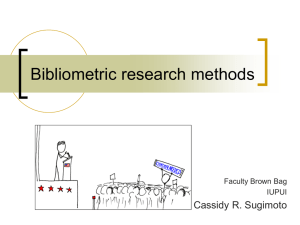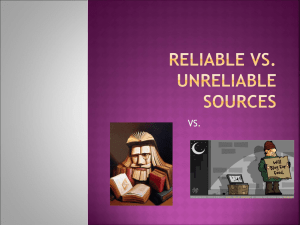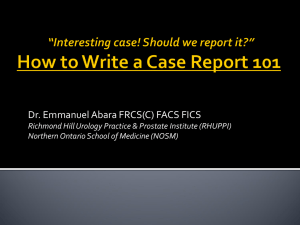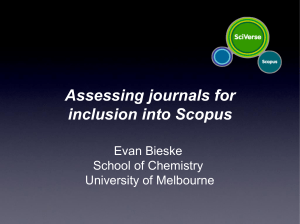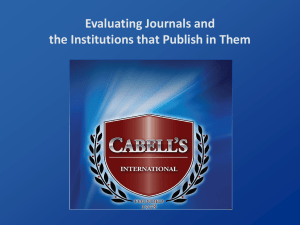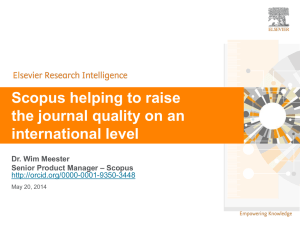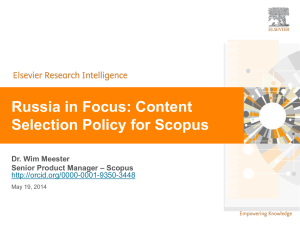Getting smarter at publishing 2014
advertisement
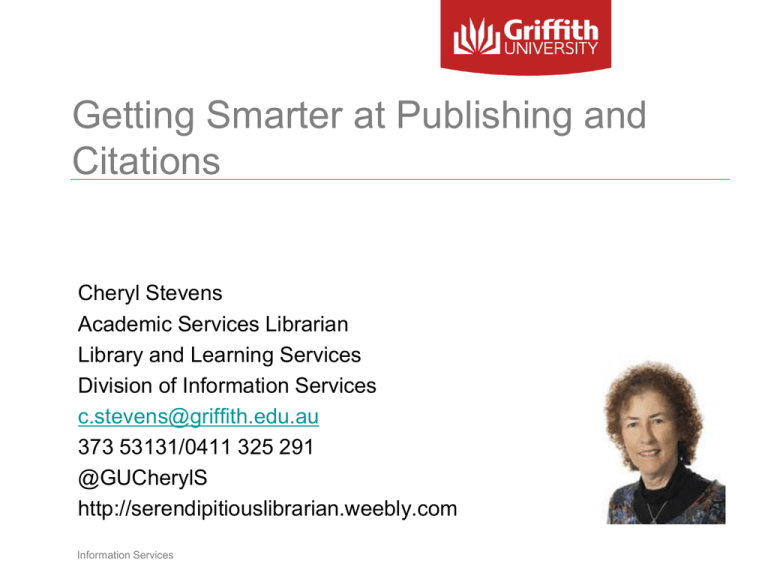
Getting Smarter at Publishing and Citations Cheryl Stevens Academic Services Librarian Library and Learning Services Division of Information Services c.stevens@griffith.edu.au 373 53131/0411 325 291 @GUCherylS http://serendipitiouslibrarian.weebly.com Information Services University’s research agenda • It is important to be able to show the value of academic research • But we all want our research to be seen, read, used and have impact Information Services Session aims to help you • Make informed decisions about where to publish = journal impact • Understand the significance of citation measures in the publishing process = publications impact; i.e. how to access citations and how to increase them Information Services Selecting a suitable journal • Readership – academic, industry, general public • Peer-reviewed – if you wish other researchers to read and cite your research • Journal quality/prestige – impact factors (ECR aim low to build up output and esteem first) • Relevance – check journal aims and scope • Publisher policies - open access & selfarchiving Information Services Sources of journal information • Experienced researchers/colleagues • Your own bibliography - chances are if you are citing from specific journal, you will be writing something of equal interest to other readers of that journal • Ulrichsweb = Periodical Directory • Databases in your field – which journals come up the most often when searching • Journal impact databases (WoS/Scopus) Information Services Journal impact measures • Measure of the frequency with which the "average article" in a journal has been cited in a specific year or period – if high impact (e.g. Nature = 38.597), then is read and cited widely within its discipline and publishes important, high-quality work; 5 low for science but high for social science publication; education highest IF is 4.229 • Quantitative method of evaluating journals - not a substitute for qualitative measures such as peerreview Information Services Journal impact sources • Scopus Journal Analyzer • Journal Citation Reports (Web of Science) • ERA journal ranking – no longer used; but see ERA 2012 journal list as list of active, peer reviewed, scholarly journals that publish original research (2015 list not published yet) http://www.arc.gov.au/era/era_2012/era_journ al_list.htm Information Services Scopus Journal Analyzer Information Services Scopus Journal Analyzer Information Services Journal Citation Reports (WoS) Information Services Be aware of where you publish • Beall’s List provides a list of predatory scholarly openaccess publishers http://scholarlyoa.com/2012/12/06/bealls-list-ofpredatory-publishers-2013/ • “Criteria for determining predatory open-access publishers” by Jeffrey Beall (2nd edition) http://scholarlyoa.com/2012/11/30/criteria-fordetermining-predatory-open-access-publishers-2ndedition/ Information Services Session aimed to help you • Make informed decisions about where to publish a) Identify potential journals to publish in b) Compare the performance of different journals within a specific discipline c) Highlight journals that provide highest impact and/or reach d) Which journals not to publish in Information Services Professional reading • Wolfson, A.J., Brooks, M.A., Kumbier, A.L., & Lenares, D.A. (2013). Monitoring and promoting the impact of pedagogically related scholarship. Biochemstry and Molecular Biology, 41(6), 365368 http://onlinelibrary.wiley.com.libraryproxy.griffith.ed u.au/journal/10.1002/(ISSN)1539-3429 Information Services Professional reading • “A World Digital Library is coming true!” by Robert Darnton, The New York Review of Books http://www.nybooks.com/articles/archives/2014/ may/22/world-digital-library-coming-true/ Information Services Live demonstration – Ulrichsweb, Scopus Journal Analyzer, Journal Citation Reports (Web of Science) Session aims to help you • Understand the significance of citation measures in the publishing process Information Services Publishing models • Traditional Contract between you and publisher to reproduce, distribute and sell your work for a fee Subscription model – individual or institutional Citation and abstract only freely available • Open access Freely available to all for viewing or downloading Gold OA – provides immediate OA to all of its articles on the publisher’s website Green OA – authors publish in any journal and then selfarchive preprint/postprint in GRO or on other OA website Information Services Open access journals • Benefits Greater exposure Universal access Easier discovery Often faster timeline to publication Retain own copyright under Creative Commons Greater indexing and retrieval • Costs May be direct cost to you or your institution May be too new to be indexed by major databases May not have an impact factor yet Information Services OA and citation impact Information Services Finding open access journals • Open access publishers Directory of Open Access Journals ( DOAJ) http://doaj.org/ Ulrichsweb: browse to find open access Elsevier journal finder (limit to open access) http://journalfinder.elsevier.com Information Services Open access repositories • Author self-archiving repositories Griffith Research Online Social Science Research Network (SSRN) • Open Access to Knowledge (OAK) – Publishing agreements and publishers' open access policies List http://www.oaklist.qut.edu.au/ • SHERPA RoMEO - Publisher's copyright & archiving policies http://www.sherpa.ac.uk/romeo/ Information Services Information Services Research Impact How is research impact measured? • Research impact generates funding • Prestige/impact of journal • Number of citations – individual researcher and at institutional level • H index – to do with publications • Commercialisation – visitor hits on websites; downloads of papers (eprints) • Altmetrics: http://altmetrics.org/manifesto/ Information Services H index • Measure of number of publications published (= productivity) and how often they are cited (= impact) • Based on citation data • A researcher with an H index of 15 has at least 15 papers which have been cited 15 times Information Services Citation databases • Scopus • Web of Science (Science, Social Sciences and Arts & Humanities Citation Indexes; Book Citation Indexes) • Google Scholar » » » » free coverage broader than Web of Science or Scopus includes theses, books, book chapters useful to Business, Arts, Education and Humanities • Publish or Perish : Anne-Wil Harzing Information Services How to raise citation levels (1) • Pick as distinctive a version of your author name as possible • Choose appropriate and distinctive titles and sub-titles, and appropriate keywords for indexing • Write informative article titles, abstracts and book blurbs http://blogs.lse.ac.uk/impactofsocialsciences/thehandbook/chapter-4-getting-better-cited/ • Work with colleagues to produce multi-authored outputs – across universities and/or countries • Collaborate with peers with a publishing history Information Services How to raise citation levels (2) • Consider cross-disciplinary research projects • Build communication and dissemination plans into research plans early on • Always put a version of any output on the open web; e.g. Griffith Research Online • Publish in high-profile, high-impact journals and know your journals and impact factor • Know your ERA relevant field of research codes; e.g. Division 13 = Education, 1302 Curriculum and Pedagogy Information Services How to raise citation levels (3) • Self-citations count – keep self-citation rate in line with academics in the same discipline • Publish review articles • Rework conference papers into articles • Get yourself known – conferences, think tanks, community groups, consultancies, web presence • Build scholarly networks via social media – au.linkedin.com; academia.edu (keep your information up-to-date); Twitter Information Services How to raise citation levels (4) • Journal articles seem to attract higher citations than chapters in books and conference papers; perhaps simply because they are easier to locate • Register with Google Scholar Citations Service, ORCID (http://orcid.org/) - takes 30 secs, Researcher ID (Web of Science), Author ID (Scopus) • Proven researcher – Professor Stephen Billett, Adult and Vocational Education – h-index of 45; 8103 citations over his career • Education researchers need to be connected to respond more effectively to global issues Information Services Summary: • Produce a piece of well written, top quality, original research • Get it out there in the highest quality refereed journal that you can • Credit the right author – consistent form of your name and ORCID is recommended • Check and verify the final proofs of your work regarding your name and affiliation • Make it open as evidence supports that open access papers are more highly cited • Promote your work by telling EVERYONE! As @johnwlamp says: It’s no longer a matter of ‘publish or perish’, but ‘be visible or vanish’. Information Services Publishing research + generating research impact secures funding for the growth of the university and future research initiatives. Information Services Further reference: publishing + impact • Griffith Library’s Support for Researchers guide get published (includes Open access) measure impact Information Services Live demonstration – Google Scholar Citations profile, Scopus Altmetrics Thank you!
